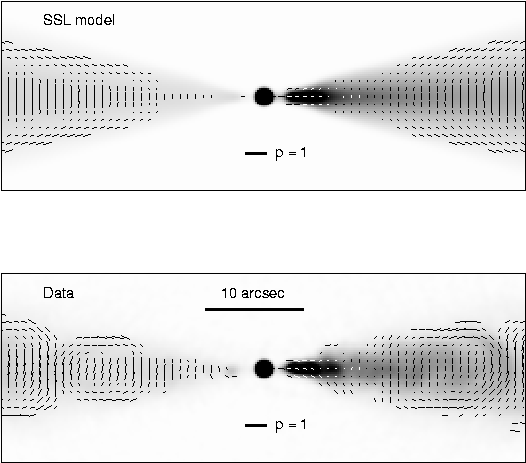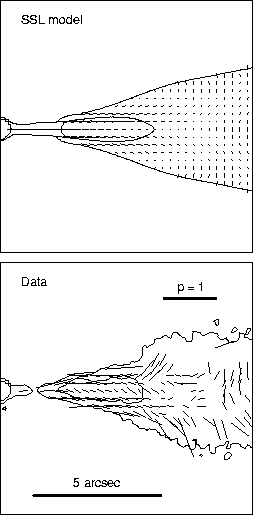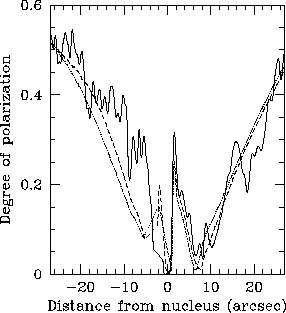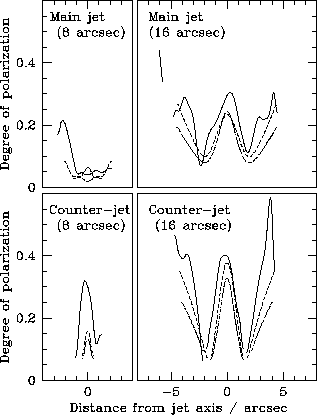



Next: 4.2 Model parameters and confidence limits
Up: 4.1 Comparison between models and data
Previous: 4.1.5 Fitted polarization features
The models are in principle incapable of fitting non-axisymmetric or
small-scale features. The most important examples of these, emphasized in
the plots of  for Stokes I and U (Fig. 5)
are as follows:
for Stokes I and U (Fig. 5)
are as follows:
- The inner and flaring regions of the main and counter-jets have fine
structure consisting of small numbers of discrete knots. These are
modelled as continuous features with the correct mean level
(Fig. 9).
- The observed apparent magnetic field direction is oblique to the jet
axis in the centre of the flaring region of the main jet
(Fig. 14): this cannot be reproduced in any purely axisymmetric
model.
- The prominent arc of emission 20 to 24arcsec from the nucleus in
the main jet is not reproduced either in total intensity or linear
polarization.
Figure 13:
Vectors whose lengths are proportional to the degree of
polarization, p, and whose directions are those of the apparent magnetic
field superimposed on grey-scale images of total intensity at 0.75 arcsec
resolution. Top: spine/shear-layer model; bottom: VLA data. The vectors
are blanked as in Fig. 12.
 |
Figure 14:
Vectors whose lengths are proportional to the degree of
polarization, p, and whose directions are those of the apparent magnetic
field superimposed on contours of total intensity at 0.25 arcsec
resolution. Top: spine/shear-layer model;
bottom: VLA data. The observed vectors are blanked on polarized and
total intensity, as in Fig. 12, but the model vectors are
plotted wherever the total intensity exceeds  , regardless of
polarized flux.
, regardless of
polarized flux.
 |
Figure 15:
Profile of the degree of polarization
along the jet ridge line at 0.75 arcsec
resolution. Full line: data; dashed line: spine/shear layer fit; dotted
line: Gaussian fit.
 |
Figure 16:
Example transverse profiles of the degree of polarization
at distances of 8arcsec from the
core in the flaring region (left panels) and 16arcsec from the core
in the outer region (right panels). Top panels: main jet; bottom panel:
counter-jet.
Full line: data; dashed line: spine/shear-layer fit; dotted line:
Gaussian fit. The profiles are blanked as in Fig. 12 and the
resolution is 0.75arcsec.
 |
In addition, there are small but significant deviations between observed and
modelled polarization patterns in the flaring region:
- The apparent field vectors between 5 and 7 arcsec
from the nucleus in the main jet diverge more from the axis than is predicted
(Fig. 14). The degree of polarization also appears to be
underestimated, but the signal-to-noise ratio at 0.25 arcsec
FWHM is quite low and that the observed vectors are blanked on polarized
flux. There is therefore a tendency for the degree of polarization to be
spuriously high for the plotted vectors. This effect has been corrected to
first order (Section 2.3), but some residual remains.
- The degree of polarization along the ridge-line of the counter-jet
is underestimated, significantly so between 3 and 10 arcsec from the core
(Figs 15 and 16).

![]() for Stokes I and U (Fig. 5)
are as follows:
for Stokes I and U (Fig. 5)
are as follows:



